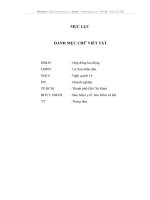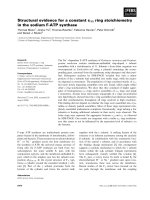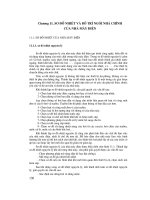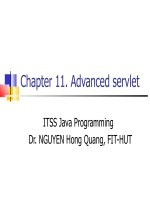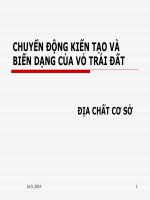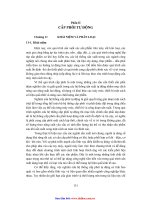C1177 c11
Bạn đang xem bản rút gọn của tài liệu. Xem và tải ngay bản đầy đủ của tài liệu tại đây (28.01 KB, 3 trang )
Designation: C 1177/C 1177M – 99
Standard Specification for
Glass Mat Gypsum Substrate for Use as Sheathing1
This standard is issued under the fixed designation C 1177/C 1177M; the number immediately following the designation indicates the
year of original adoption or, in the case of revision, the year of last revision. A number in parentheses indicates the year of last
reapproval. A superscript epsilon (e) indicates an editorial change since the last revision or reapproval.
4. Materials and Manufacture
4.1 Glass Mat Gypsum Substrate shall consist of a noncombustible water-resistant core, essentially gypsum, surfaced with
glass mat partially, or completely embedded in the core.
4.2 Glass Mat Gypsum Substrate, type X (special fireresistant) designates glass mat gypsum substrate complying
with this specification that provide not less than 1 h fire
resistance for substrate 5⁄8 in. [15.9 mm] thick or 3⁄4 h fire
resistance for substrate 1⁄2 in. [12.7 mm] thick, applied parallel
with and on each side of load bearing 2 by 4 wood studs spaced
16 in. [406 mm] on center with 6d coated nails, 17⁄8 in. [48
mm] long, 0.0915 in. [2.3 mm] diameter shank, 1⁄4 in. [6.4 mm]
diameter heads, spaced 7 in. [178 mm] on center with glass mat
gypsum substrate joints staggered 16 in. [406 mm] on each side
of the partition and tested in accordance with Test Methods
E 119.
1. Scope
1.1 This specification covers glass mat gypsum substrate,
which is designed to be used as an exterior substrate for a
weather barrier.
1.2 The values stated in either inch-pound units or SI
(metric) are to be regarded separately as standard. Within the
text, the SI units are shown in brackets. The values stated in
each system shall be used independently of the other. Values
from the two systems shall not be combined.
1.3 The text of this standard references notes and footnotes
that provide explanatory material. These notes and footnotes
(excluding those in tables and figures) shall not be considered
as requirements of the standard.
2. Referenced Documents
2.1 ASTM Standards:
C 11 Terminology Relating to Gypsum and Related Building Materials and Systems2
C 473 Test Methods for Physical Testing of Gypsum Board
Panel Products2
C 645 Specification for Nonstructural Steel Framing Members2
C 1264 Specification for Sampling, Inspection, Rejection,
Certification, Packaging, Marking, Shipping, Handling,
and Storage of Gypsum Board.2
E 119 Test Methods for Fire Tests of Building Construction
and Materials3
NOTE 1—Consult manufacturers for independent test data on assembly
details and fire resistance classifications for other types of construction.
See official fire test reports for assembly particulars, materials, and
classifications.
5. Physical Properties
5.1 Specimens shall be taken from the samples obtained in
accordance with Specification C 1264.
5.2 Specimens shall be tested in accordance with Methods
C 473.
5.2.1 Flexural Strength—The specimens shall be tested face
up and face down. The average breaking load shall not be less
than the following:
3. Terminology
3.1 Definitions shall be in accordance with Terminology
C 11.
3.2 Definitions of Terms Specific to This Standard:
3.2.1 glass mat, n—a mat of glass fibers with or without a
binder.
3.2.2 edge, n—the bound edge as manufactured.
3.2.3 weather barrier, n—a material that prevents the passage of rain, sleet and snow.
Method B
Thickness,
in. [mm]
⁄ [6.4]
⁄ [12.7]
5⁄8 [15.9]
14
12
Load, lbf [N] Bearing Load, lbf [N] Bearing edges
edges perpendicular to
parallel to the substrate
the substrate edge
edge
50 [222]
100 [445]
140 [623]
40 [178]
80 [356]
100 [445]
5.2.2 Humidified Deflection—Specimens shall have an average deflection of not more than the following:
1
This specification is under the jurisdiction of ASTM Committee C-11 on
Gypsum and Related Building Materials and Systems and is the direct responsibility
of Subcommittee C11.01 on Specifications and Test Methods for Gypsum Products.
Current edition approved Oct. 10, 1999. Published December 1999. Originally
published as C 1177 – 91. Last previous edition C 1177 – 96.
2
Annual Book of ASTM Standards, Vol 04.01.
3
Annual Book of ASTM Standards, Vol 04.07.
Thickness,
in. [mm]
Humidified deflection,
eighths of an in. [mm]
⁄ [6.4]
⁄ [12.7]
⁄ [15.9]
not applicable
2 [6]
1 [3]
14
12
58
5.2.3 Core, End and Edge Hardness—Specimens shall have
Copyright © ASTM, 100 Barr Harbor Drive, West Conshohocken, PA 19428-2959, United States.
1
C 1177/C 1177M
an average hardness of not less than 15 lbf [67 N] when tested
in accordance with Method B:
5.2.4 Nail-Pull Resistance—Specimens shall have an average nail-pull resistance of not less than the following when
tested in accordance with Method B:
Thickness,
in. [mm]
Nail pull resistance,
lbf [N]
⁄ [6.4]
⁄ [12.7]
⁄ [15.9]
40 [178]
80 [356]
90 [400]
14
12
58
Thickness,
in. [mm]
Length
ft [mm]
Variation
in. [mm]
⁄ [6.4]
⁄ [12.7]
5⁄8 [15.9]
4 to 8 [1220 to 2440]
6 to 12 [1840 to 3660]
6 to 12 [1840 to 3660]
+ 1⁄4[6]
6 1⁄4 [6]
6 1⁄4 [6]
14
12
6.2.4 End Squareness—Corners shall be square with a
tolerance of 61.8 in. [63 mm] in the full width of the
substrate.
6.2.5 Edges and Ends—The edges and ends shall be straight
and either square, recessed, beveled, featured, tapered, or
featured and tapered.
5.2.5 Water Resistance—The three specimens selected shall
have an average water absorption of not more than 10 weight
% after a 2-h immersion.
7. Finish and Appearance
7.1 Glass mat gypsum substrate shall be free of any cracks
and imperfections that would render it unfit for its designed
use.
6. Dimensions and Tolerances
6.1 Specimens shall be taken from the samples obtained in
accordance with Specification C 1264.
6.2 Thickness, width, length and end squareness shall be
determined in accordance with Test Methods C 473.
6.2.1 Thickness—The nominal thickness shall be
1⁄4, 1⁄2 or 5⁄8 in. [6.4, 12.7 or 15.9 mm], with tolerances in the
nominal thickness of 6 1⁄32 in. [60.8 mm], and with local
variations of 6 1⁄16 in. [61.6 mm] from the nominal thickness.
6.2.2 Width—The nominal width shall be up to 48 in. [1220
mm], with tolerance of 1⁄8 in. [3 mm] under the specified
width.
6.2.3 Length—The nominal length and tolerance shall be as
follows:
8. Sampling, Inspection, Rejection, Certification,
Packaging, Marking, Shipping, Handling, and Storage
8.1 Shall be in accordance with C 1264.
9. Keywords
9.1 core; exterior substrate; fire resistant classification; flexural strength; glass mat; glass mat gypsum substrate; gypsum;
hardness; humidified deflection; nail pull resistance; noncombustible; sheathing; substrate; type X; water resistance;
weather barrier
APPENDIX
(Nonmandatory Information)
This Appendix gives general information information and also suggestions for inclusions to be made elsewhere by the
specifier. They are not part of this specification.
The definitions of type X as given in 4.2 and the alternate definition given in this appendix, are intended only as a test to
define glass mat gypsum substrate for use as sheathing as meeting the requirements of type X. These tests do not indicate a
preferred application nor do they limit the use of the product in other fire related assemblies.
All gypsum panel products use the same test for type X products, therefore the type X designation indicates a consistent level
of fire resistance.
X1. ALTERNATE DEFINITION FOR TYPE X
ing with Specification C 645 spaced 24 in. [610 mm] on center.
The 5⁄8 in. [15.9 mm] thick glass mat gypsum substrate 48 in.
[1220 mm] wide shall be attached using 1 in. [25 mm] long
drywall screws spaced 8 in. [203 mm] on center along the
edges and ends, and 12 in. [305 mm] along intermediate studs.
All joints shall be oriented parallel to and located over studs
and staggered on opposite sides of the assembly; and
X1.1.2 Two hours for a 1⁄2 in. [12.7 mm] thickness applied
to a partition in a double layer application on each side of
21⁄2 in. [64 mm] deep non-loadbearing galvanized steel studs
X1.1 Glass mat gypsum substrate, type X (special fireresistant) designates glass mat gypsum substrate providing a
greater fire resistance than regular glass mat gypsum substrate
of the same thickness. Type X (special fire-resistant) glass mat
gypsum substrate, when tested in accordance with Test Methods E 119, shall provide the following minimum fire resistance
for the assemblies described:
X1.1.1 One hour for a 5⁄8 in. [15.9 mm] thickness applied to
a partition in a single layer application on each side of 35⁄8 in.
[92 mm] deep non-loadbearing galvanized steel studs comply2
C 1177/C 1177M
complying with Specification C 645 spaced 24 in. [610 mm] on
center. The base layer 48 in. [1220 mm] wide shall be attached
using 1 in. [25 mm] long drywall screws spaced 12 in. [305
mm] on center along substrate edges, ends and along intermediate studs. Joints shall be oriented parallel to and located over
studs and staggered on opposite sides of the assembly. The face
layer 48 in. [1220 mm] wide shall be attached using 15⁄8 in. [41
mm] long drywall screws spaced 12 in. [305 mm] along
substrate edges, ends and along intermediate studs. Joints shall
be oriented parallel to and located over studs, offset 24 in. [610
mm] from the base layer joints, and staggered on opposite sides
of the assembly.
The American Society for Testing and Materials takes no position respecting the validity of any patent rights asserted in connection
with any item mentioned in this standard. Users of this standard are expressly advised that determination of the validity of any such
patent rights, and the risk of infringement of such rights, are entirely their own responsibility.
This standard is subject to revision at any time by the responsible technical committee and must be reviewed every five years and
if not revised, either reapproved or withdrawn. Your comments are invited either for revision of this standard or for additional standards
and should be addressed to ASTM Headquarters. Your comments will receive careful consideration at a meeting of the responsible
technical committee, which you may attend. If you feel that your comments have not received a fair hearing you should make your
views known to the ASTM Committee on Standards, at the address shown below.
This standard is copyrighted by ASTM, 100 Barr Harbor Drive, PO Box C700, West Conshohocken, PA 19428-2959, United States.
Individual reprints (single or multiple copies) of this standard may be obtained by contacting ASTM at the above address or at
610-832-9585 (phone), 610-832-9555 (fax), or (e-mail); or through the ASTM website (www.astm.org).
3


